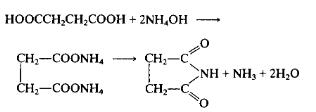Succinimid Chemische Eigenschaften,Einsatz,Produktion Methoden
R-Sätze Betriebsanweisung:
R36/37/38:Reizt die Augen, die Atmungsorgane und die Haut.
S-Sätze Betriebsanweisung:
S22:Staub nicht einatmen.
S24/25:Berührung mit den Augen und der Haut vermeiden.
S36:DE: Bei der Arbeit geeignete Schutzkleidung tragen.
S26:Bei Berührung mit den Augen sofort gründlich mit Wasser abspülen und Arzt konsultieren.
Aussehen Eigenschaften
C4H5NO2; Bernsteinsäureimid. Feinkristallines, farbloses Pulver, fast geruchlos.
Gefahren für Mensch und Umwelt
Zu vermeidende Stoffe sind Amide. Brennbar.
LD
50 (oral, Ratte): 14000 mg/kg
Schutzmaßnahmen und Verhaltensregeln
Schutzhandschuhe als kurzzeitiger Staubschutz
Verhalten im Gefahrfall
Trocken aufnehmen, der Entsorgung zuführen.
Kohlendioxid, Wasser, Pulver
Brennbar. Im Brandfall können Stickoxide entstehen.
Erste Hilfe
Nach Hautkontakt: Mit viel Wasser abwaschen.
Nach Augenkontakt: Mit viel Wasser und geöffnetem Lidspalt mindestens 10 Minuten ausspülen.
Nach Einatmen: Frischluft.
Nach Verschlucken: Viel Wasser trinken, Erbrechen auslösen. Bei Unwohlsein Arzt aufsuchen.
Nach Kleidungskontakt: Kontaminierte Kleidung sofort entfernen.
Ersthelfer: siehe gesonderten Anschlag
Sachgerechte Entsorgung
Laborchemikalienabfälle.
Chemische Eigenschaften
white crystalline powder
Verwenden
Succinimide is used in organic syntheses and in industrial silver plating processes. It is a reagent that is used in the synthesis of Lumiflavin (L473900), which is a toxic photolysis product of vitamin B2 (R415000). Further, it is used to form covalent bonds between proteins, peptides and plastics. In addition to this, it is used as an important raw material for the synthesis of heterocyclic compounds through N-acyliminium cyclizations.
Definition
ChEBI: Succinimide is a dicarboximide that is pyrrolidine which is substituted by oxo groups at positions 2 and 5. It is a pyrrolidinone and a dicarboximide.
synthetische
To a flask equipped with a dropping funnel, mechanical stirrer, and a 40 cm long side arm of not less than 10 mm inside diameter is added 236 gm (2.0 mole) of succinic acid. The flask is cooled and 270 ml (4.0 moles) of 28% aqueous ammonia is slowly added with stirring. The flask is rapidly heated with an oil bath until 200 ml of water distils. The temperature of the bath is rapidly raised to 275°C. Succinimide starts to distil over the range 275-289°C, to afford 168 gm of crude product which solidifies on cooling. The intermediate fraction, boiling between 102° and 275°C, is redistilled to afford 10.0 gm of crude succinimide, b.p. 275-289°C. The combined product (178 gm) is added to 178 gm of hot ethanol. The solution is cooled, the crystals filtered, washed with 25 ml of cold ethanol, and dried to afford 163-164 gm (82-83%), m.p. 123-125°C. Approximately 4-5 gm of additional product may be obtained by concentrating the mother liquor.
Recent Japanese patents suggested inert aprotic solvents such as cyclic amides (e.g., N-methylpyrrolidone, N-acetyl-2-pyrrolidone, DMF, or tet-ramethylurea) and azeotroping solvents (e.g., toluene, 0-xylene, hexane, or pentane) or other high-boiling solvents (e.g., chlorobenzene or chlo-rotoluene) as dehydrating agents for the formation of imides from dibasic acids (e.g., 3- and/or 4) hydroxyphthalic acid with a large variety of diamines including diaminosiloxanes such as bis (3-aminopropyl)-tetra-methylsiloxane.

läuterung methode
Crystallise the imide from EtOH (1mL/g) or water. [Beilstein 21 H 369, 21/9 V 438.]
Succinimid Upstream-Materialien And Downstream Produkte
Upstream-Materialien
Downstream Produkte

